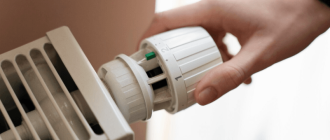In today’s world, energy efficiency is a top concern for homeowners. With rising energy costs and growing environmental awareness, choosing the right windows for your home has never been more important. Two popular options that homeowners often compare in terms of savings and energy efficiency are single-hung and double-hung windows.
Single-hung windows are a classic choice that have been around for centuries. They are a cost-effective option that typically feature a fixed top sash and a movable bottom sash. On the other hand, double-hung windows offer more versatility, with both the top and bottom sashes being operable.
When it comes to energy efficiency, double-hung windows have the edge. Their ability to open from both the top and bottom allows for better ventilation, which can help regulate indoor temperatures and reduce the need for heating or cooling. Additionally, double-hung windows often have a tighter seal when closed, preventing drafts and air leakage, which can lead to energy loss and higher utility bills.
While single-hung windows may not offer the same level of energy efficiency, they still have their advantages. They are generally more affordable and require less maintenance compared to their double-hung counterparts. Single-hung windows also have a simpler design, making them less prone to mechanical issues over time. If you live in a climate that doesn’t experience extreme temperature fluctuations, single-hung windows can still be a viable option.
Ultimately, the choice between single-hung and double-hung windows depends on your specific needs and budget. If energy efficiency and flexibility are top priorities, double-hung windows are the way to go. However, if cost and simplicity are more important to you, single-hung windows can still provide adequate insulation and functionality.
Energy Efficiency: Single-Hung vs Double-Hung Windows
When it comes to energy efficiency, homeowners have a lot of options to choose from, including single-hung and double-hung windows. Both types of windows can contribute to energy savings in your home, but each has its own advantages and disadvantages.
Single-Hung Windows
Single-hung windows are a popular choice for many homeowners due to their affordability and simplicity. These windows have a fixed top sash and a bottom sash that can be opened vertically. While single-hung windows can provide some level of energy efficiency, they are generally less efficient than double-hung windows.
One reason for this is that single-hung windows only have one movable sash, which can limit ventilation and airflow. This means that they may not provide as effective insulation against drafts and outdoor temperatures. Additionally, single-hung windows typically have fewer weatherstripping and sealing options compared to double-hung windows, which can further reduce their energy efficiency.
Double-Hung Windows
Double-hung windows offer increased energy efficiency compared to single-hung windows. These windows have two movable sashes, allowing for greater control over ventilation and airflow. By opening both the top and bottom sashes, you can create a cross breeze that helps cool your home in the summer. Additionally, double-hung windows often have more weatherstripping and sealing options, which can improve their insulation and energy efficiency.
Another advantage of double-hung windows is their ease of cleaning. Both sashes can be tilted inward, making it easier to clean the exterior and interior surfaces of the window. This can help maintain the efficiency of the windows over time, as dirt and debris can build up on the glass and affect their performance.
Comparison
When comparing the energy efficiency of single-hung and double-hung windows, it is important to consider factors such as insulation, ventilation, and sealing options. While single-hung windows are generally more affordable, they may not provide the same level of energy savings as double-hung windows.
However, double-hung windows may come with a higher upfront cost. It is important to weigh the long-term energy savings against the initial investment to determine which option is best for your home and budget.
In conclusion, while both single-hung and double-hung windows can contribute to energy efficiency, double-hung windows generally offer greater insulation, ventilation, and sealing options. This can result in increased energy savings and a more comfortable living environment for homeowners.
What are single-hung windows?
Single-hung windows are a type of window design that is commonly found in residential homes. They are known for their traditional and classic appearance, making them a popular choice for homeowners looking to maintain the aesthetic integrity of their home. Single-hung windows are designed with two sashes, where the top sash is fixed in place and the bottom sash can be opened vertically.
Efficiency and Installation
One of the key factors that homeowners consider when choosing windows is their energy efficiency. When it comes to energy-efficient windows, single-hung windows offer several advantages. The fixed top sash of single-hung windows helps to minimize air leakage, making them more efficient in maintaining indoor temperature and reducing energy loss.
Additionally, single-hung windows are relatively easy to install compared to other window types. Their simplistic design and operation make them suitable for a variety of window sizes and shapes, making the installation process smoother and quicker.
Comparison and Savings
When comparing single-hung windows to double-hung windows, it’s important to note that double-hung windows offer more versatility in terms of ventilation options. However, single-hung windows are generally more energy-efficient due to the fixed top sash, which prevents air infiltration and helps reduce heating and cooling costs in the long run.
Homeowners who prioritize energy savings may find single-hung windows to be a better choice, especially in regions with extreme weather conditions. The energy savings achieved with single-hung windows can contribute to lower utility bills and a more environmentally friendly home.
In summary, single-hung windows are a popular and energy-efficient choice for homeowners. Their traditional appearance and simple design make them suitable for a variety of home styles. With their energy-saving benefits and easy installation process, single-hung windows offer an attractive option for those looking to upgrade their windows and improve the efficiency of their homes.
Advantages of single-hung windows
When it comes to the installation of windows, single-hung windows offer several advantages that can benefit homeowners. One of the main advantages of single-hung windows is their cost savings compared to other window types, such as double-hung windows.
Cost savings
Single-hung windows are generally more affordable to purchase and install compared to double-hung windows. This cost advantage can be appealing to homeowners who are on a budget or looking to save money on their home improvement projects. Additionally, the installation process for single-hung windows is often simpler and requires less time and effort compared to double-hung windows, further adding to the cost savings.
Energy-efficient
While double-hung windows are known for their energy efficiency, single-hung windows can also provide significant energy savings. Single-hung windows feature a fixed upper sash and a vertically sliding lower sash, which helps to minimize air leakage and improve insulation. The limited movement of the single sash reduces the potential for draftiness and heat loss, making them a suitable choice for homeowners who prioritize energy efficiency.
Moreover, single-hung windows typically have fewer moving parts compared to double-hung windows, reducing the chances of wear and tear and improving their overall efficiency. The absence of movable sashes also eliminates the need for complex weatherstripping systems, simplifying maintenance and enhancing the window’s energy-saving capabilities.
When comparing the efficiency of single-hung and double-hung windows, it’s important to note that single-hung windows generally have higher insulation properties due to their fixed upper sash. This can result in lower energy bills and increased comfort for homeowners.
In conclusion, while double-hung windows may have their advantages, single-hung windows offer cost savings, energy efficiency, and simplified installation and maintenance processes. These advantages make single-hung windows an attractive option for homeowners looking to enhance the efficiency and functionality of their homes, especially when compared to double-hung windows.
Disadvantages of single-hung windows
While single-hung windows are a popular choice for many homeowners, they do come with a few disadvantages when compared to double-hung windows. These disadvantages can impact both the installation process and the long-term energy savings.
Limited ventilation options
One of the main disadvantages of single-hung windows is their limited ventilation options. Unlike double-hung windows, single-hung windows only have one operational sash that moves up and down. This means that only the bottom sash can be opened, restricting the amount of fresh air that can enter a room. In contrast, double-hung windows offer the flexibility of opening both the top and bottom sashes, allowing for better air circulation and ventilation.
Difficult to clean
Another disadvantage of single-hung windows is their cleaning process. Since only the bottom sash is operable, cleaning the exterior of the top sash can be a challenge, especially for windows installed on higher floors. Double-hung windows, on the other hand, can be tilted or easily removed for cleaning, making the maintenance process more convenient.
Furthermore, the installation process for single-hung windows can be more complex compared to double-hung windows. Double-hung windows have a balanced sash system that allows for easier installation and removal if needed. Single-hung windows, however, require the installation of a fixed top sash, which can add complexity and potentially increase the overall installation cost.
In summary, while single-hung windows may offer certain advantages, such as cost savings, they also have downsides in terms of ventilation options, cleaning convenience, and installation complexity. For those looking for a more energy-efficient and versatile option, double-hung windows offer a better comparison.
What are double-hung windows?
Double-hung windows are a popular choice among homeowners for their versatility and energy efficiency. Unlike single-hung windows, which have a fixed top sash and a bottom sash that can be raised or lowered, double-hung windows feature two movable sashes that can be operated independently. This allows for better control of airflow and ventilation.
One of the key benefits of double-hung windows is their ease of installation. They can be installed in any type of opening, making them a versatile option for various home styles. Additionally, double-hung windows provide better energy efficiency compared to single-hung windows. The ability to open both sashes allows for more air circulation, which can help regulate the temperature inside the home and reduce the need for heating or cooling. This can lead to significant energy savings for homeowners.
In comparison to single-hung windows, double-hung windows offer enhanced ventilation options. Homeowners have the flexibility to open the top sash, the bottom sash, or both simultaneously, allowing for greater control over airflow. This is particularly advantageous during the warmer months when fresh air is desired without compromising security.
Another advantage of double-hung windows is their easier maintenance. Both sashes can be tilted inward for cleaning, which makes it convenient for homeowners to keep their windows clean and well-maintained. This feature can be especially beneficial for windows located on higher floors.
All in all, double-hung windows offer a range of benefits, including improved energy efficiency, enhanced ventilation options, and easier maintenance. They can be a great investment for homeowners looking to improve their home’s overall comfort and energy savings.
| Installation | Versatile – can be installed in any type of opening |
| Single-hung Windows | Fixed top sash, only bottom sash can be moved |
| Efficiency | Better energy efficiency compared to single-hung windows |
| Savings | Potential for significant energy savings |
| Comparison | Enhanced ventilation options and easier maintenance compared to single-hung windows |
| Double-hung Windows | Two movable sashes that can be operated independently |
| Windows | Improved control of airflow and ventilation |
Advantages of double-hung windows
When comparing the energy efficiency of single-hung and double-hung windows, it’s clear that double-hung windows offer several advantages to homeowners. These advantages can lead to significant savings in energy costs and improve the overall efficiency of your home.
One of the main advantages of double-hung windows is their ability to provide better insulation. With two moving sashes, rather than just one in single-hung windows, double-hung windows create a tighter seal when closed. This improved insulation helps keep the outside air from entering your home and the conditioned air from escaping, resulting in reduced energy waste and lower utility bills.
Additionally, double-hung windows offer more ventilation options compared to single-hung windows. Both the top and bottom sashes of double-hung windows can be opened, allowing for increased airflow and better control over natural ventilation. This can be particularly beneficial during the warmer months when you want to let in fresh air without relying on air conditioning.
Another advantage of double-hung windows is their ease of cleaning. Unlike single-hung windows, where only the bottom sash can be operated, double-hung windows can be tilted inward for easy cleaning of both the inside and outside surfaces. This feature makes window maintenance less time-consuming and more convenient for homeowners.
Furthermore, double-hung windows often offer better installation flexibility. Due to their design, they can fit into a wider range of window openings, making them suitable for various architectural styles and home designs. This versatility allows homeowners to choose double-hung windows that complement their home’s aesthetic while still benefiting from their energy-efficient qualities.
In conclusion, the advantages of double-hung windows in terms of energy efficiency, ventilation options, ease of cleaning, and installation flexibility make them a favorable choice for homeowners looking to upgrade their windows. The initial investment in double-hung windows can lead to long-term savings and improved comfort in your home.
Disadvantages of double-hung windows
While double-hung windows are generally considered to be energy-efficient and offer a range of benefits, they do have a few disadvantages compared to single-hung windows.
1. Cost of installation
Double-hung windows typically require more complex installation compared to single-hung windows. This may result in higher installation costs, especially if the existing window frames need to be modified or replaced to accommodate double-hung windows. Additionally, the weight and size of double-hung windows can make them more difficult to handle during installation.
2. Lack of complete weather seal
Double-hung windows typically have multiple moving parts, such as sashes and tracks, which can create potential areas for air leakage. This can reduce the overall energy efficiency of the windows and result in higher energy bills. Proper weather stripping and regular maintenance can help mitigate this issue, but it adds an additional upkeep requirement compared to single-hung windows.
Comparison table of single-hung and double-hung windows:
| Feature | Single-Hung Windows | Double-Hung Windows |
|---|---|---|
| Operation | Only the bottom sash can be opened | Both the top and bottom sashes can be opened |
| Energy Efficiency | Good | Generally good, but potential for air leakage |
| Cost | Lower | Higher |
| Maintenance | Less maintenance required | More maintenance required |
| Style | Traditional appearance | Versatile design options |
In conclusion, double-hung windows offer versatility and the ability to increase ventilation, but they may require higher installation costs and have a higher likelihood of air leakage compared to single-hung windows. Consider your specific needs, budget, and energy efficiency priorities when choosing between single-hung and double-hung windows for your home.
Energy efficiency of single-hung windows
When it comes to choosing windows for their homes, homeowners are often concerned with energy efficiency. Windows can contribute to significant energy savings, and comparing different types of windows can help homeowners make an informed decision. One popular option is single-hung windows.
Single-hung windows are a type of window that features a fixed upper sash and a lower sash that can be opened vertically. While they may not offer the same level of versatility as double-hung windows, single-hung windows can still provide significant energy savings.
One key factor that contributes to the energy efficiency of single-hung windows is their installation. Properly installed single-hung windows can help prevent air leakage, reducing drafts and improving overall energy efficiency. Additionally, the use of high-quality materials and weatherstripping can further enhance the energy efficiency of these windows.
Single-hung windows are also known for their durability and low-maintenance characteristics. This can result in long-term energy savings for homeowners, as they won’t need to invest as much time and money into window maintenance and repairs.
While single-hung windows may not offer the same level of ventilation options as double-hung windows, they can still provide excellent energy efficiency. With proper installation and maintenance, single-hung windows can be a cost-effective and energy-efficient choice for homeowners.
In conclusion, when it comes to energy efficiency, single-hung windows can offer homeowners significant savings. With their efficient installation, durable materials, and low-maintenance characteristics, these windows can provide excellent energy efficiency and contribute to a more energy-efficient home.
Energy efficiency of double-hung windows
When it comes to comparing the energy efficiency of single-hung and double-hung windows, double-hung windows often come out on top. Their design and functionality allow for better insulation and greater energy savings for homeowners.
One of the main reasons why double-hung windows are more energy efficient is because they have two operable sashes that can be opened and closed independently. This allows for better control over the airflow and temperature inside your home, as you can open the top sash for ventilation while the bottom sash remains closed.
In comparison, single-hung windows only have one operable sash, typically the bottom sash, while the top sash remains fixed. This can limit your ability to control the airflow and temperature, reducing the overall energy efficiency of these windows.
Another factor that contributes to the energy efficiency of double-hung windows is the installation. Double-hung windows often have better sealing mechanisms, such as weatherstripping and interlocking sashes, which help to prevent air leaks and drafts. This means that less conditioned air can escape and less outside air can infiltrate your home, resulting in energy savings and increased comfort.
Additionally, double-hung windows are often available with Low-E glass and argon gas fillings, which further enhance their energy efficiency. Low-E glass helps to reflect heat back into your home during the winter and block out heat during the summer, reducing the reliance on heating and cooling systems. Argon gas fillings provide additional insulation, improving the overall energy performance of the windows.
| Advantages of Double-Hung Windows | Advantages of Single-Hung Windows |
|---|---|
| Two operable sashes for better airflow control | Lower initial cost |
| Better sealing mechanisms to prevent air leaks | Less maintenance required |
| Option for Low-E glass and argon gas fillings | Traditional and classic design |
| Increased energy savings and home comfort | Common and readily available |
In conclusion, when comparing the energy efficiency of single-hung and double-hung windows, double-hung windows provide homeowners with greater control over airflow and temperature, better sealing mechanisms, and the option for additional energy-saving features. While single-hung windows may have a lower initial cost and a traditional design, the long-term energy savings and comfort offered by double-hung windows make them a more efficient choice for your home.
Factors Affecting Energy Efficiency
When it comes to energy efficiency, the choice between single-hung and double-hung windows can make a significant difference. Here are some key factors that can affect the energy efficiency of these window types:
- Window Efficiency: Both single-hung and double-hung windows can be energy-efficient if they are properly designed and sealed. Look for windows with low U-factor and Solar Heat Gain Coefficient (SHGC) ratings, as these indicate better insulation and heat control capabilities.
- Double-Hung Design: Double-hung windows offer the advantage of being able to open from both the top and bottom sash. This allows for better ventilation and natural airflow control, which can help regulate indoor temperatures and reduce reliance on energy-consuming appliances like air conditioners.
- Installation Quality: Regardless of which window type you choose, proper installation is crucial for maximizing energy efficiency. Poor installation can lead to air leakage and heat transfer, negating the benefits of energy-efficient windows. Hiring professional installers or following manufacturer guidelines for installation is recommended.
- Homeowners’ Habits: Energy efficiency is not solely determined by the window type. Homeowners can also play a role in energy savings by adopting energy-conscious habits, such as drawing curtains or blinds during hot summer days to block solar heat, or using window films or insulated drapes to improve insulation.
By considering these factors and choosing the right windows for your home, you can significantly increase your energy efficiency and enjoy long-term energy savings.
Q&A:
What is the difference between single-hung and double-hung windows?
Single-hung windows have a fixed top sash and a movable bottom sash, while double-hung windows have both top and bottom sashes that can be opened and closed.
Which type of window is more energy-efficient, single-hung or double-hung?
Generally, double-hung windows are considered to be more energy-efficient than single-hung windows due to their ability to open from both the top and bottom, allowing for greater airflow and ventilation.
Can single-hung windows be as energy-efficient as double-hung windows?
While single-hung windows can still provide good energy efficiency if properly installed and sealed, they may not offer the same level of ventilation and air circulation as double-hung windows, which can affect their overall energy efficiency.
Are there any advantages to choosing single-hung windows over double-hung windows?
Single-hung windows are generally more affordable than double-hung windows, and they have fewer moving parts, which can make them easier to maintain. However, they do not offer the same level of flexibility and ventilation as double-hung windows.
Are there any disadvantages to choosing double-hung windows over single-hung windows?
Double-hung windows may be more expensive than single-hung windows, and they can also require more maintenance and potential repairs due to their movable sashes. However, their energy efficiency and versatility often outweigh these potential drawbacks.
What is the difference between single-hung and double-hung windows?
Single-hung windows have a stationary top sash and a bottom sash that can be raised for ventilation. Double-hung windows have two movable sashes that can be raised or lowered independently, allowing for more ventilation options.







